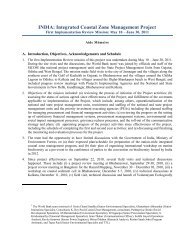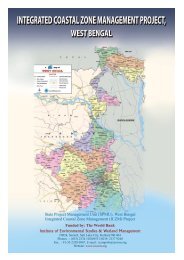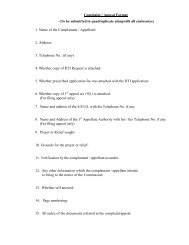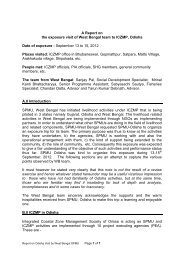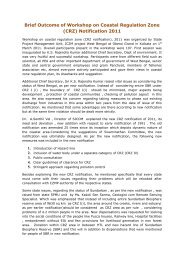Cyclone and Storm Surge - Iczmpwb.org
Cyclone and Storm Surge - Iczmpwb.org
Cyclone and Storm Surge - Iczmpwb.org
You also want an ePaper? Increase the reach of your titles
YUMPU automatically turns print PDFs into web optimized ePapers that Google loves.
3.20<br />
the ocean level as a result of storm surges. This causes flow accumulation in the drainage channels,<br />
which in turn, causes backflow into the city.<br />
The waterlogging problem may be ascribed to the typical geographical feature of the city being of<br />
saucer type, the central portion being of lower elevatron <strong>and</strong> pumping is required to remove the<br />
waterlogging as there is hardly any scope for gravitational drainage. The eastward drainage does not<br />
pose much serious problems while the areas, viz. Amherst Street, Thanthania, Chitpur, Free School<br />
Street, Camac Street, Sarat Basu Road where sewers have a north-south alignment have chronic<br />
waterlogging problem. The inadequate road surface area of the city of only 6-8 percent aggravates<br />
the waterlogging problem. The storm water from the buildings instead of draining into the sewers<br />
through the yard gullies is discharged onto the inadequate road surface. Moreover, the gully pits on<br />
the roads, through which the water should drain out are inadequate in number <strong>and</strong> often choked<br />
owing to lack of maintenance. Further, rain washes solid waste to the mouths of gully pits, blocking<br />
the free flow of water into them. Besides, the city sewer system has no separate dry weather <strong>and</strong><br />
storm weather flow arrangement thus resulting in major <strong>and</strong> minor underground trunk sewer lines<br />
being badly silted up for absence of cleaning at regular intervals <strong>and</strong> this has made the reduction in<br />
flowing capacity of storm weather flow considerably to the extent of about 30 percent.<br />
3.14. Drainage of Bidhan Nagar (Salt Lake)<br />
Salt lake is divided into three zones namely Sector I, Sector II, <strong>and</strong> Sector III which have different<br />
topographical <strong>and</strong> consequential drainage features. While storm water of Sector I, <strong>and</strong> Sector II flow<br />
into Kestopur Canal by gravitation, nearly 40 percent of the drainage of Sector III is effected by the<br />
pumping station at DE-block <strong>and</strong> rest through gravitation flow into Eastern Drainage Canal. It can<br />
easily be understood the vital part these two canals namely Kestopur <strong>and</strong> Eastern Drainage Canal<br />
play in overall storm water management of Salt Lake. Since both these two canals originate from<br />
Kolkata desilting of these two canals will contribute a lot for swift drainage of Salt Lake, in addition to<br />
the benefit of Kolkata Municipal area.<br />
It must be remembered that Bidhan Nagar was formed by filling up of low-lying marshy l<strong>and</strong>s with<br />
s<strong>and</strong> from the river Hooghly. Not all places of the reclaimed l<strong>and</strong> was filled up the same extent.<br />
Hence, certain portions of the township which are not that high suffer fromdrng congestion. Also, the<br />
drainage channels of Kestopur Canal <strong>and</strong> the Eastern Drainage Canal have silted up considerably<br />
from their original design sections, resulting in backflow of the township’s internal storm water<br />
drainage.









